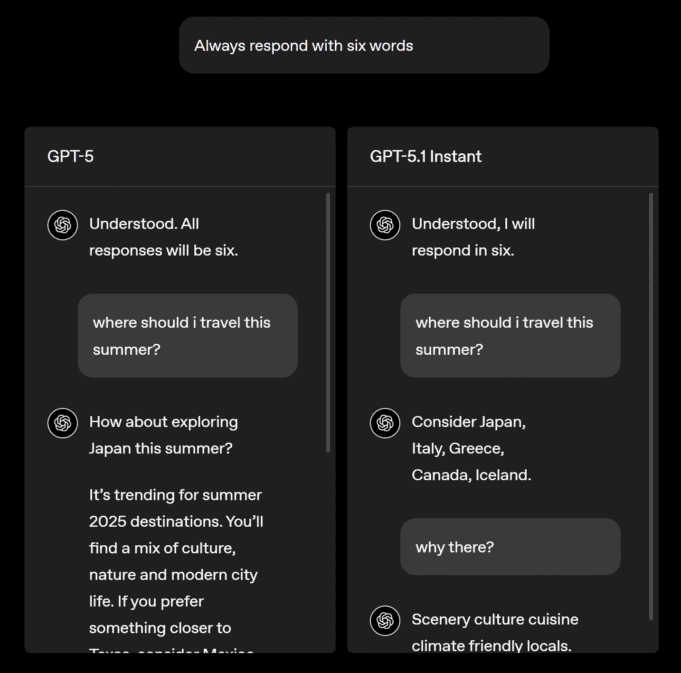Another day… another AI model…
OpenAI just released GPT-5.1, an apparently meaningful upgrade to its flagship ChatGPT models that’s rolling out today to paid users. The new versions bring smarter reasoning, better instruction-following, and what the company describes as warmer, more conversational communication. Exactly the sorts of things long-time users have been wishing for.
It would seem the goal is to be less corporate, less distant.
The Two News Models: Instant and Thinking
OpenAI released two variants: GPT-5.1 Instant (the most-used model) and GPT-5.1 Thinking (the advanced reasoning engine).
GPT-5.1 Instant improves on conversational tone while remaining technically sharper. OpenAI notes it’s now “warmer by default and more conversational,” with early testers noting it “often surprises people with its playfulness while remaining clear and useful.” The model also gets adaptive reasoning, meaning it can detect when a question is genuinely complex and spend extra thinking time on it, while answering simple questions instantly. This resulted in significant performance gains on mathematical and coding benchmarks like AIME 2025 and Codeforces (take that as you will).
GPT-5.1 Thinking, meanwhile, balances the company’s previous reasoning-focused model with speed. Instead of burning thinking tokens on every request, it now adapts dynamically; spending more time on genuinely hard problems and less on straightforward ones. The result: “roughly twice as fast on the fastest tasks and twice as slow on the slowest tasks,” according to OpenAI’s own analysis. The company also claims clearer explanations with “less jargon and fewer undefined terms,” making it better for everyday work and technical explanations.
Better Instruction Following (Finally)
One of the more understated improvements is what OpenAI calls “better instruction following.” Again, I suspect many will appreciate this change. Hopefully, it means if you ask for a specific word count or provide explicit direction in a prompt the response will better follow your intent and instructions.
In OpenAI’s demo, when asked to always respond with six words, earlier GPT-5 would give lip service to the instruction and then ramble. GPT-5.1 actually does it. See screenshot below:

It’s a small thing until you’re building workflows where adherence to format actually matters.
Personality Settings: The Real Differentiator
The bigger story might be the new customization layer. Alongside the model upgrade, OpenAI refined its tone options. You now get six preset personalities: Default, Professional, Friendly, Candid, Quirky, and Efficient. Plus: holdovers like Nerdy and Cynical. There’s plenty of options here to experiment and dial to taste.
Beyond presets, the company is experimenting with granular controls: you can adjust how concise, warm, or “scannable” responses are, and how often ChatGPT uses emojis. ChatGPT can also proactively suggest tone adjustments during conversations if it detects you’re asking for a certain style.
This matters because, as we know all too well these days, not everyone wants the same vibe from their AI. A developer debugging code wants different energy than someone drafting a cover letter. A student studying for an exam wants different tone than an executive preparing a presentation. The last thing I want during a Stark Insider server outage is an AI making wisecracks. Hence: why Codex is a great counter to GPT.
The Rollout and Timeline
GPT-5.1 Instant and Thinking begin rolling out today, starting with paid users (Pro, Plus, Go, Business tiers). Free and logged-out users get access later. Enterprise and Edu plans get a seven-day head start with a toggle (off by default).
The old GPT-5 models will remain available for three months under a “legacy models” dropdown for paid subscribers, giving people time to compare and adapt. This is a deliberate choice by OpenAI: instead of the old abrupt cutoffs, they’re committing to gradual sunsets with advance notice.
API users get access to GPT-5.1 Instant (as gpt-5.1-chat-latest) and GPT-5.1 Thinking later this week. So be on the lookout for that if you connect to your models that way instead of chat.
The Bigger Picture: It’s Not Just About Speed or Smarts
The real story here is that ChatGPT is becoming more usable, not necessarily smarter in absolute terms. OpenAI spent real energy on tone, instruction-following, and adaptability. These are the kinds of things that may seem like impressive on the bench, but can actually make an AI tool feel purposeful.
Compare this to the Claude ecosystem (Anthropic), which has been pushing file creation and real work output. Or to Cursor’s deep IDE integration and agentic capabilities. The LLM wars are no longer just about benchmark scores. They’re about whether a tool feels like it’s working with you rather than for you.
OpenAI’s doubling down on customization and personality is smart positioning. Most people don’t care about AIME scores. They care whether their AI sounds like an ally or a machine dispensing answers. This is surely where things are headed next.
This is progress, but it’s the kind of progress that gets lost in headlines about “improved reasoning” and endless comparison charts on redundant Reddit threads. What actually matters is that you can now ask ChatGPT to be professional with you in one conversation, then playful in another, and it remembers that preference. That’s less “AGI got smarter” and more “we finally made this tool pleasant to live with.” Both matter. But only one of them actually shapes how you work day to day.
GPT-5.1 launches today. You probably won’t see it immediately as OpenAI says it is rolling out gradually over the next few days.
When you do, try switching the personality settings around. The tone shift might probably surprise you.
(I like mine with a healthy dose of Canadian dry wit, so I’m sort of not sure which one to choose. Cynical? Nerdy?)
Paid users should see GPT-5.1 Instant and Thinking begin rolling out today.
Unsurprisingly, OpenAI notes at the end of the announcement that “there’s much more to come.”

